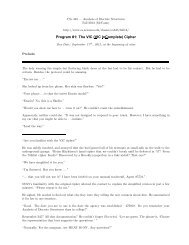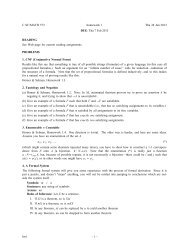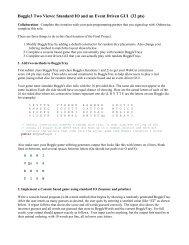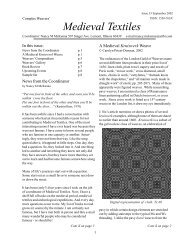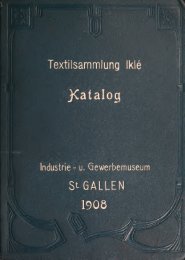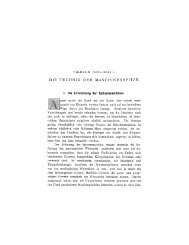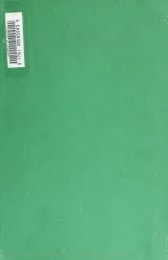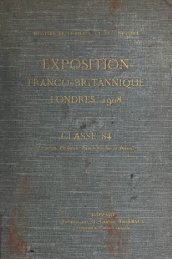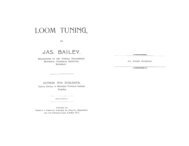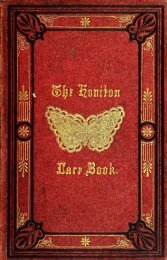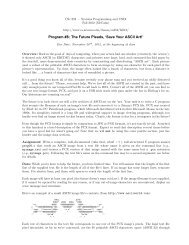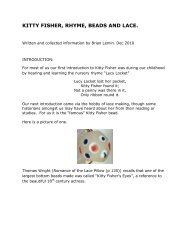The Priscilla Battenberg and point lace book; a collection of lace ...
The Priscilla Battenberg and point lace book; a collection of lace ...
The Priscilla Battenberg and point lace book; a collection of lace ...
Create successful ePaper yourself
Turn your PDF publications into a flip-book with our unique Google optimized e-Paper software.
large loops.<br />
<strong>The</strong> fourth<br />
row consists,<br />
like the<br />
second, <strong>of</strong><br />
the large<br />
loops p<strong>lace</strong>d<br />
Fig. 111. Bkussbls Net.<br />
each time on<br />
the middle<br />
loop <strong>of</strong> the group <strong>of</strong> stitches above. <strong>The</strong><br />
fifth row, like the third, consists <strong>of</strong> four button-<br />
hole stitches on each <strong>of</strong> the loops above.<br />
Diamond Stitch in Brussels Net.<br />
<strong>The</strong> diamond arrangement <strong>of</strong> Brussels net<br />
stitches shown in Fig. 112 is very showy <strong>and</strong> ef-<br />
fective for filling in large spaces. Groups <strong>of</strong> six<br />
rather closely set buttonhole stitches are worked<br />
at regular intervals with a space between the<br />
groups equal to<br />
the width <strong>of</strong> one<br />
<strong>of</strong> them, <strong>and</strong> with<br />
the loop kept long.<br />
<strong>The</strong> second row<br />
consists <strong>of</strong> a group<br />
o f three buttonhole<br />
stitches worked<br />
into the three<br />
middle loops <strong>of</strong> each group above <strong>and</strong> three<br />
buttonhole stitches worked on each long loop.<br />
<strong>The</strong> third row is composed <strong>of</strong> groups <strong>of</strong> six<br />
stitches worked under each three <strong>of</strong> the preceding<br />
row, two stitches to the left <strong>of</strong> the first stitch<br />
above, one on each loop <strong>and</strong> two to the right <strong>of</strong><br />
the last or third stitch. <strong>The</strong> loops between the<br />
groups are left long <strong>and</strong> the next row, like the<br />
second, consists <strong>of</strong> three stitches in each long<br />
loop <strong>and</strong> three below the groups <strong>of</strong> six.<br />
Spanish <strong>and</strong> Brussels Net.<br />
Figure 113 is a simple combination <strong>of</strong> Spanish<br />
<strong>and</strong> Brussels net stitches. As the Spanish net<br />
stitch is always worked more<br />
Fig. 113. Spanish<br />
<strong>and</strong> Brussels<br />
Net.<br />
112. Diamond Stitch in<br />
Bbdssels Net.<br />
easily from left to right the<br />
work is begun at the left <strong>and</strong><br />
a single row <strong>of</strong> the Spanish<br />
net stitches (Fig. 58), T^orked<br />
across the space. <strong>The</strong> second<br />
row consists <strong>of</strong> a single Brus-<br />
sels net stitch (Fig. 38),<br />
worked in the loop between<br />
eadh <strong>of</strong> the Spanish net stitches<br />
above. <strong>The</strong>se rows <strong>of</strong> Spanish <strong>and</strong> Brussels net<br />
are worked alternately until the space is filled.<br />
Ringed Raleigh Bars.<br />
This is one<br />
<strong>of</strong> the richest<br />
<strong>and</strong> most<br />
beautiful o f<br />
the <strong>lace</strong><br />
stitches <strong>and</strong><br />
will greatly<br />
add to the<br />
beauty <strong>of</strong> any<br />
piece <strong>of</strong> <strong>lace</strong><br />
in which it is<br />
used ; see Fig.<br />
114. <strong>The</strong><br />
rings may be<br />
the fine<br />
Fig. 114. Ringed Raleigh Baes.<br />
Flemish machine-made variety or they may be<br />
made by the worker. When this is preferred the<br />
foundation <strong>of</strong> each- ring is prepared by winding<br />
the thread a sufficient number <strong>of</strong> times around a<br />
43<br />
ring gauge (Fig. 1) or other suitable cylindrical<br />
implement. <strong>The</strong>se windings are held together by<br />
overcasting them with the working thread, <strong>and</strong><br />
the rings, not yet buttonholed, are basted into<br />
position on the pattern. <strong>The</strong>y may be spaced<br />
regularly <strong>and</strong> the bars arranged in a geometrical<br />
design as shown in the illustration or they<br />
may be p<strong>lace</strong>d without regard to design <strong>and</strong> the<br />
bars put in according to necessity—:either ef-<br />
fect is good. After the rings have all been se-<br />
curely fastened to the pattern by means <strong>of</strong> a<br />
sufficient number <strong>of</strong> stitches to hold them se-<br />
curely the bars are worked. <strong>The</strong> thread is fas-<br />
tened to the braid at any <strong>point</strong>, carried across<br />
to the nearest ring, <strong>and</strong> through it, <strong>and</strong> the bar<br />
so made covered closely with buttonhole stitches<br />
back to the braid. At any given <strong>point</strong> in the<br />
bar a picot<br />
may be<br />
p<br />
1 a c e d .<br />
This i s<br />
made by<br />
working<br />
three close<br />
button -hole<br />
stitches be-<br />
t w e e n the<br />
Fig. 115. Insertion<br />
last two on the bar <strong>and</strong> then continuing the<br />
buttonholing, until the bar is completed. Often<br />
these bars must be from ring to ring <strong>and</strong> not



